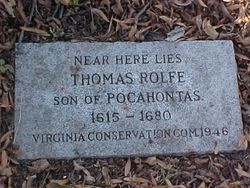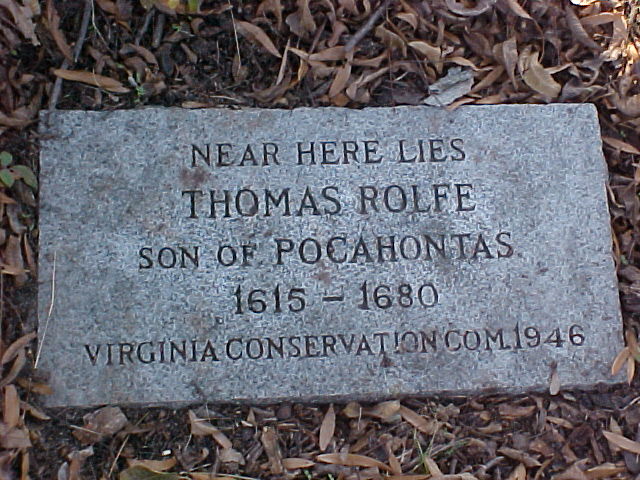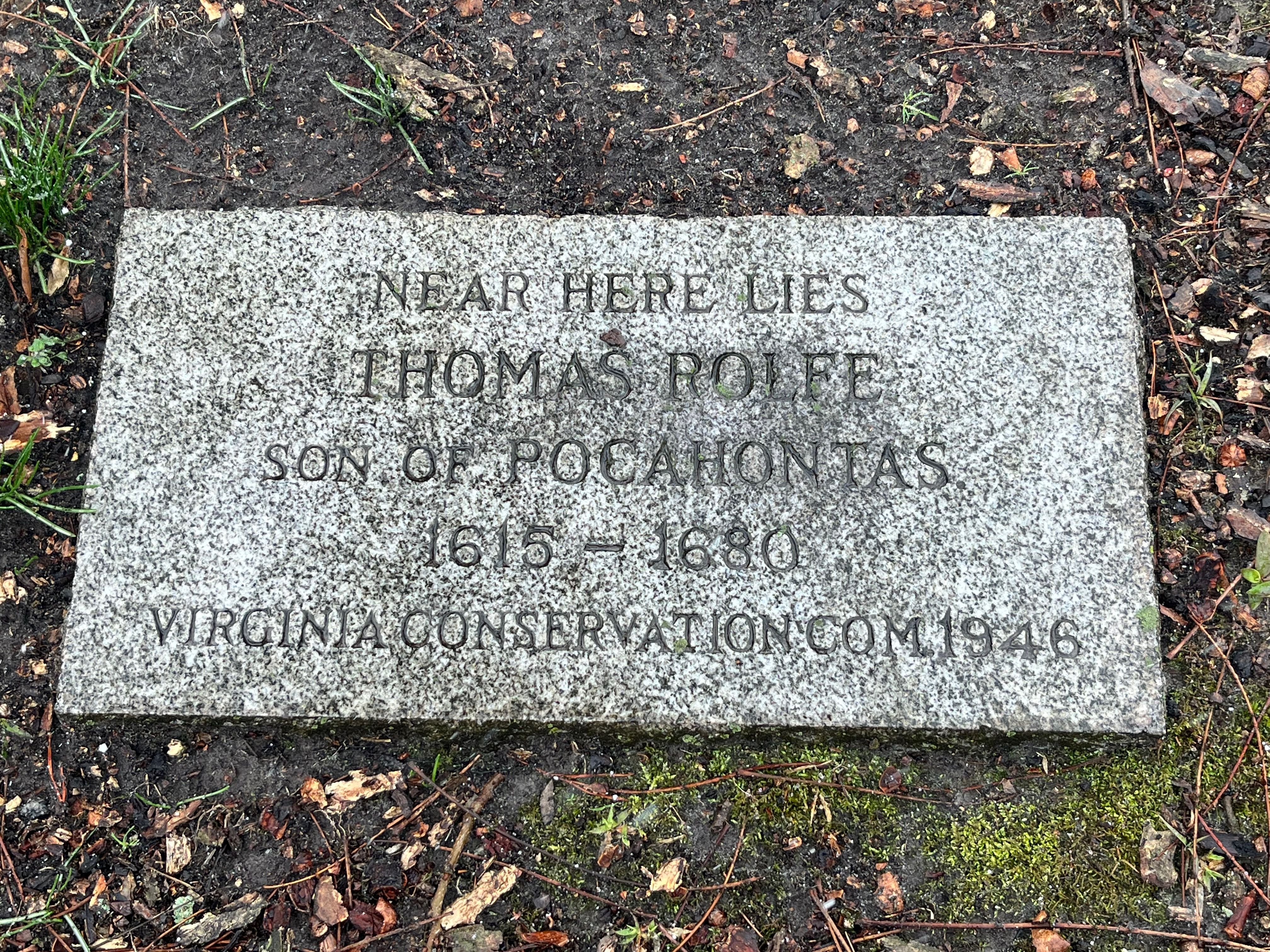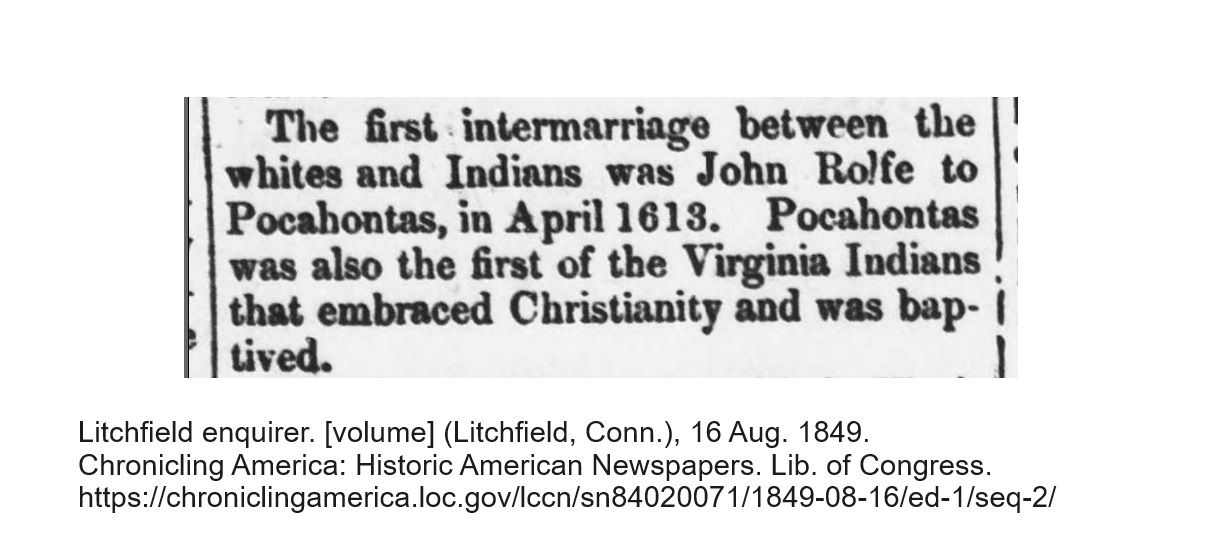Colonial American Figure. His mother was Pocahontas whose father was Chief Powhatan of a federation of the Algonquian Indian tribes of the tidewater region of Virginia The father of Thomas Rolfe was John Rolfe, a member of the House of Burgess & credited with establishing the planting of tobacco in Virgina Colony.
Thomas was born in the Virginia Colony, probably on Smith's plantation at Jamestown. His mother, Pocahontas, daughter of Chief Powhatan, gave up her native birth name and took the Christian name of Rebecca when she married John Rolfe.
Thomas' parents' marriage was as much a political action as an action of affection. In John's petition to the Governor for permission to marry Pocahontas, he stated both reasons.
When still an infant, Thomas went to England with his parents, where his mother died about seven months later. His father left him there to be raised in guardianship, while he returned to business interests in Virginia.
Since Thomas spent his childhood in the white society of England and the Virginia Colony, he thought of himself as an Englishman. When he reached adulthood, history recorded that the Virginia Governor granted Thomas permission to meet his Native American uncle, Opechancanough. Nothing was noted of the outcome of this meeting, however.
He served as a lieutenant in the English military, and was granted land at Fort James. By the time he died, his estate showed he held more than one deed and land grant, so he was a man of means in Colonial Virginia.
He married Jane Poythress, and their only child, Jane, married Colonel Robert Bolling. The Bollings had a son, John. He had seven children.
Some researchers suggest Thomas died at age 61 in 1674/75; However a property event dating 23 Apr 1681, lands of Thomas Rolfe, deceased, known as "the Fort Land" were divided and sold - so he was clearly gone before 23 Apr 1681; His only grandson, John Bolling, signed over some of his land in 1698 to a William Brown.
Bibliography:
The Association for the Preservation of Virginia, copyright 1997,2000 at website antiquitieshttp://www.apva.org/history/jrolfe.html
Colonial National Historic Park Jamestown, Historic Briefs: Thomas Rolfe by Megan Snow, NPS Intern from William and Mary
May 2003 at website
http://www.nps.gov/colo/Jthanout/ThomasRolfe.htm
Brown, Stuart E., Lorraine F. Myers, and Eileen M. Chappel. Pocahontas' Descendants. Baltimore: Genealogical Publishing Co., Inc., 1994.
Stanard, William. Virginia Magazine of History and Biography, Volume 21. New York: Kraus Reprint Corporation, 1968.
Early Virginia Families Along the James River: Their Deep Roots and Tangled Branches, Volume III, page 73 (distribution of lands after 1680)
Colonial American Figure. His mother was Pocahontas whose father was Chief Powhatan of a federation of the Algonquian Indian tribes of the tidewater region of Virginia The father of Thomas Rolfe was John Rolfe, a member of the House of Burgess & credited with establishing the planting of tobacco in Virgina Colony.
Thomas was born in the Virginia Colony, probably on Smith's plantation at Jamestown. His mother, Pocahontas, daughter of Chief Powhatan, gave up her native birth name and took the Christian name of Rebecca when she married John Rolfe.
Thomas' parents' marriage was as much a political action as an action of affection. In John's petition to the Governor for permission to marry Pocahontas, he stated both reasons.
When still an infant, Thomas went to England with his parents, where his mother died about seven months later. His father left him there to be raised in guardianship, while he returned to business interests in Virginia.
Since Thomas spent his childhood in the white society of England and the Virginia Colony, he thought of himself as an Englishman. When he reached adulthood, history recorded that the Virginia Governor granted Thomas permission to meet his Native American uncle, Opechancanough. Nothing was noted of the outcome of this meeting, however.
He served as a lieutenant in the English military, and was granted land at Fort James. By the time he died, his estate showed he held more than one deed and land grant, so he was a man of means in Colonial Virginia.
He married Jane Poythress, and their only child, Jane, married Colonel Robert Bolling. The Bollings had a son, John. He had seven children.
Some researchers suggest Thomas died at age 61 in 1674/75; However a property event dating 23 Apr 1681, lands of Thomas Rolfe, deceased, known as "the Fort Land" were divided and sold - so he was clearly gone before 23 Apr 1681; His only grandson, John Bolling, signed over some of his land in 1698 to a William Brown.
Bibliography:
The Association for the Preservation of Virginia, copyright 1997,2000 at website antiquitieshttp://www.apva.org/history/jrolfe.html
Colonial National Historic Park Jamestown, Historic Briefs: Thomas Rolfe by Megan Snow, NPS Intern from William and Mary
May 2003 at website
http://www.nps.gov/colo/Jthanout/ThomasRolfe.htm
Brown, Stuart E., Lorraine F. Myers, and Eileen M. Chappel. Pocahontas' Descendants. Baltimore: Genealogical Publishing Co., Inc., 1994.
Stanard, William. Virginia Magazine of History and Biography, Volume 21. New York: Kraus Reprint Corporation, 1968.
Early Virginia Families Along the James River: Their Deep Roots and Tangled Branches, Volume III, page 73 (distribution of lands after 1680)
Inscription
NEAR HERE LIES
THOMAS ROLFE
SON OF POCAHONTAS
1615-1680
VIRGINIA CONSERVATION COM. 1946
Gravesite Details
Some researchers question why his daughter, Mrs. Bolling, is memorialized next to him instead of his last wife. Since the marker notes blood relationships only, the group erecting it was likely noting his historical significance - not wives












